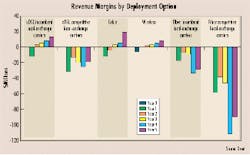DSL is not the only access option for local loop, warns market analyst
Demand for faster Internet service has led many customers to choose DSL, which, in turn, has prompted many to speculate that DSL is the broadband-access method of the future. However, a new report from independent research and consulting company Ovum (London) warns that the cost and complexity of deploying DSL may be discouraging to new entrants, who should explore other access methods before deployment.
"Technology costs are only the tip of the iceberg for operators and new entrants," asserts Yum Petkovic, Ovum analyst and lead author of the report. "The cost of interconnection can often form the biggest expense, even leaving aside the cost of rolling out a new network." he adds.
Ovum's report offers an in-depth analysis of four viable access-technology methods: DSL, wireless local loop, fiber-to-the-home, and cable modems-each of which offers different capabilities and restrictions. An access method that can be rapidly deployed will build a customer base, but operators must also consider cost-effectiveness and lifetime and performance issues. Also, geographical considerations, including regulations, population density, and the sophistication of the existing network, must be taken into account.In the United States, for example, DSL may be less successful, as it is unable to cover long distances without significant noise distortion. Despite the initial cost of deployment, fiber-to-the-home seems to be the favored option in the U.S. (see Figure). According to the report, its time frame to profitability can be improved by methods of provisioning other than digging-for example, in places where it can be fed through an existing sewage system. For ILECs and CLECs with an established network, fiber can be a serious contender in spite of its initial expense because of its long shelf life. In fact, the Ovum report asserts that fiber is the ultimate delivery mechanism of broadband access. It is a futureproof technology. "Once in the ground," says Ovum, "it can be used to provide limitless bandwidth dependent only on the equipment lighting up the fiber."
The report, "Broadband Access: New Business Models," examines business models designed to help network operators and new entrants determine which broadband-access technology will yield them increased revenue and market share. For more information, contact Ovum at +44 (0) 20 7551 9021 or visit their Website at www.ovum.com.

